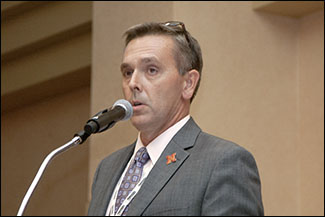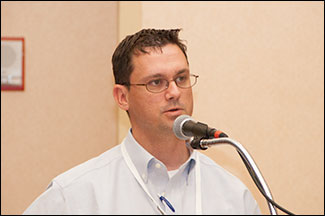In the Genomics Era,
Phenotypes Remain Important
by Troy Smith, field editor, Angus Journal®
LINCOLN, Neb. (June 19, 2014) — DNA testing to aid genetic selection may be a new technology to many if not most beef cattle producers. In fact, the emergence of cattle genomics began in the late 1980s. Back then, University of Nebraska Vice Chancellor of the Institute of Agriculture and Natural Resources Ronnie Green was a budding quantitative geneticist. Green offered his own perspective of the emergence of beef cattle genomics during the 2014 Beef Improvement Federation (BIF) symposium June 18-21 in Lincoln, Neb. Speaking to the Advancements in Emerging Technologies Committee, both he and University of Nebraska beef cattle geneticist Matt Spangler talked about how, even in this new era of genomics, there is a need for phenotypic data.

“It’s been interesting to see and hear what’s been happening in the merging of DNA technology with quantitative genetics,” stated Ronnie Green. “We’re genotyping individual animals and combining that with phenotypic data. We’ve come full circle, and it’s still going to require a lot of phenotypes to have the most useful tools for genetic prediction.”
Green said he remembers well the discussions of 25 years ago, as focus shifted from quantitative genetics (the study of inheritance through continuous measurement of traits) to molecular genetics (the study of gene function at the molecular level). He recounted the expectations for DNA technology and the excitement it spurred. As scientists moved ever closer to practical predictors of genetic merit, based on DNA, some people wondered if collection of phenotypic data might become unnecessary.
“It’s been interesting to see and hear what’s been happening in the merging of DNA technology with quantitative genetics,” stated Green. “We’re genotyping individual animals and combining that with phenotypic data. We’ve come full circle, and it’s still going to require a lot of phenotypes to have the most useful tools for genetic prediction.”

“Phenotypes are as important as they have ever been,” declared Matt Spangler “Going forward, we’ll still need progeny information flowing to breed associations to increase accuracy of prediction.”
In his comments to the Committee, Matt Spangler agreed. Involved in a multi-institution USDA grant-funded research project to develop selection tools that are genomically derived or genomically enhanced for traits affecting feed efficiency. The research involves a large number of animals representing different populations and multiple breeds. Genotypes and phenotypes will be collected from many animals. Spangler said phenotypes are needed to increase the accuracy of prediction using genotypes.
“Phenotypes are as important as they have ever been,” declared Spangler “Going forward, we’ll still need progeny information flowing to breed associations to increase accuracy of prediction.”
Spangler said the potential for improved feed efficiency, through genetic selection enabled by genomic tools, is exciting. He reminded the audience that improvement of efficiency is inherently a multiple-trait issue. Consequently, selection must be for increased profit and will require a selection index approach that considers the influences of multiple traits.
The 2014 BIF Annual Meeting & Research Symposium was hosted by the University of Nebraska–Lincoln, the U.S. Meat Animal Research Center and the Nebraska Cattlemen June 18-21 in Lincoln, Neb. The Angus Journal and LiveAuctions.tv provide comprehensive online coverage of the event at www.BIFconference.com. Visit the Newsroom for summaries, proceedings, PowerPoints and audio of the sessions; and the Awards page for announcements of award winners.
Editor’s Note: This summary was written under contract or by staff of the Angus Journal.Through an agreement with the Beef Improvement Federation, we are encouraging reprinting of the articles to those who will adhere to the reprint guidelines available on this site. Please review those guidelines or contact Shauna Rose Hermel, editor, at 816-383-5270. PowerPoints are posted with permission of the presenter and may not be reproduced in whole or in part without the express permission of the presenter.
API's coverage of the event is made possible through collaboration with BIF and sponsorship of LiveAuctions.tv. For questions about this site, or to notify us of broken links, click here.
Headquartered in Saint Joseph, Mo., API publishes the Angus Journal, the Angus Beef Bulletin, the Angus Beef Bulletin EXTRA, and the Angus Journal Daily, as well as providing online coverage of events and topics pertinent to cattlemen through the Angus Journal Virtual Library.



